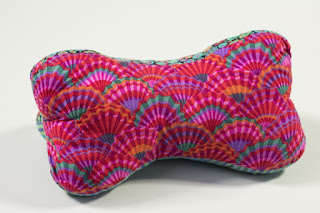If you're looking for a way to relieve stress and have an aptitude for crafts, Bonnie Browning thinks you should give quilting a try. Browning, who has quilted since the late 1970s, is a certified master quilt judge who has taught and judged quilting around the world. As the executive show director at the American Quilter's Society (AQS), she promotes the craft and the mental health benefits of this therapeutic hobby.
"If you're quilting — and I don't care if it's the up and down of the needle on your sewing machine or you're doing it with your hand — you've got the motion of the needle that you are pushing through the fabric," she said. "First of all, you need to focus on what you are doing. Then the other part is repetition. To me this is the part that is relaxing." In the process, she believes, quilters find a quiet space where they can take their minds off life's troubles.
The therapeutic benefit of quilting is the underlying theme of the latest of her 13 books on quilting, "Zentangle Art to Go," published by the AQS in August 2016. "Zentangle is a very easy drawing method in which a person defines a space into shapes and then fills that space with designs that require only a very minimum of strokes," she said. The art form was created by Rick Roberts and Maria Thomas, who compared it to an artistic form of meditation, from which they drew the name Zen. Tangle refers to the images drawn in the art form. As the method became accepted, the practice established a headquarters in Whitinsville, Massachusetts.
 Zentangle is not your grandmother's quilting pattern. (Photo: Diane MacKillop/flickr)
Zentangle is not your grandmother's quilting pattern. (Photo: Diane MacKillop/flickr)
Browning is a certified Zentangle instructor and has applied the concept to various art forms, including jewelry, but most notably to quilting. "I am a quilter, and I wanted to share this with the quilting world," she said, adding that applying the Zentangle method of drawing to quilt design just seemed logical to her.
"When you are designing the background for a quilt, it's a whole lot easier to take that background space and divide it into sections and then fill it in than it is to try to come up with a single design to fill that space. It also adds a lot more interest to a quilt. So, I took the drawing method and then adapted it to how we could use it in quilting by combining the quilting and the drawing to convert the drawing into continuous stitches on a quilt. There’s something very therapeutic about that process." It's a process that she believes can be an effective mental health therapy for all stages of life, whether it’s for children with attention deficit disorder, someone going through chemotherapy after cancer surgery or seniors in assisted living.
Is coming up with a design concept difficult? Not according to Browning, "I tell everybody if you can make a dot, a circle, a 'C,' an 'S' and draw a line, you can draw any of the Zentangle designs." These designs are typically drawn on three-and–a-half-inch tiles. "There are tons and tons and tons of designs on the Zentangle site," she said. "They don't copyright the designs because these are all designs that have been used for centuries in architecture, flooring and almost every place you look, even places like fences."
Millions of quilters
 There are a lot of quilters out there. (Photo: PHILIPIMAGE/Shutterstock)
There are a lot of quilters out there. (Photo: PHILIPIMAGE/Shutterstock)
Of course, many people are drawn to quilting as a hobby, for artistic competition or for reasons other than its therapeutic benefits. There are 16.4 million quilters in the United States with 10.3 percent of all U.S. households (12.62 million) having at least one quilter, according to the Quilting in America 2014 survey, conducted for Quilts, Inc., which is based in Houston and is the parent company of several quilting shows for the public and soft crafts industry.
If you think of these quilters in the stereotyped image of little grandmas sitting in a rocking chair sewing pieces of fabric together, Browning said to think again. "In the early days that would have been absolutely correct," she said. "And in those early days they had quilting bees. You know, it was an opportunity to get neighbors together, and they would sew together and maybe they were making a quilt for the minister. It was a social time as well as satisfying the need that they had to have blankets. That still goes on today, just exactly like that. Ladies in the church get together to make quilts for charity."
But today's quilters run the gamut of age and other demographics, said Browning. Of the AQS's 73,000 members, Browning said that while the AQS surveys show the average of their members to be about 56, "That means we have quite a few older and quite a few younger members for our medium to be that age."
Quilting as an art form can mean big prize money. The AQS, for example, will award more than $121,000 in prizes at its fall show in Paducah, Kentucky, from Sept. 13 to 16.
 Quilts make people happy. It's just science. (Photo: Maria Evseyeva/Shutterstock)
Quilts make people happy. It's just science. (Photo: Maria Evseyeva/Shutterstock)
There are also plenty of non-competitive and relaxing local and online opportunities for casual hobbyists to enjoy the craft. "Almost every city in the country has at least one quilting group," Browning said. "Sometimes they have a daytime group and a nighttime group." If you want to find a quilting group near you, just do an online search using the keywords quilt and the name of your city or town, she suggested. No matter what your interest in quilting, Browning is sure you will be able to find a group that matches those interests. If you can't find one locally, you can almost certainly find one online.
The AQS, for instance, has a free quilting community called MyQuiltPlace. "There are thousands of quilters on the site who share their quilts, and there are discussion groups of all kinds," Browning said. "It doesn’t make any difference what kind of field of quilting you are in. It's a public group, and anybody can go in there and participate to whatever level they want."
In the unlikely chance you can't find a group that piques a special interest, create one, she suggested. "If all you use is black and white fabrics, for example, you could start a black and white fabrics group. Pretty soon, you'll have a whole bunch of people in there talking to you about that. There are thousands of pictures in there of quilts that people have made from around the world." The AQS, she added, is active in every state in the U.S. and in 80 countries worldwide.
Storing quilts
 If you have a spare bed, it's the best place to store a quilt. (Photo: pyrozhenka/Shutterstock)
If you have a spare bed, it's the best place to store a quilt. (Photo: pyrozhenka/Shutterstock)
For those who are not quilters but who have a quilt that’s been handed down through generations, Browning said it’s important to know how to take care of it. Rule number one, she said, is don’t put it in a cedar chest.
"The call I get a lot is … 'I have this quilt, and we stored it in a cedar chest and now it's got brown marks on it.' Most of the time there is absolutely nothing you can do about those brown marks because they are from acid in the wood leaching into the fiber in the quilt."
The very best way to store a quilt is to put it on a spare bed and put a sheet or something clean and soft on top of it, Browning said. If you have several quilts you can pile them one on top of the other. "That puts less stress on any part of the quilt," she said.
If you want to put a quilt on a shelf in a closet, she recommends putting it in a cotton pillowcase so the quilt won’t touch anything but the pillowcase. If you do this, she advised taking the quilt out of the pillowcase every few months, refolding it in a different manner and returning it to the pillowcase so the creases are not in the same spot. This is important, she said, because the creases are hard on the fabric.
Be especially careful of exposing quilts to light as sunlight is probably the most damaging thing to quilts. "Even indirect light, just light in a room, can be hard on the fibers in a quilt," she said.
Cleaning quilts
 If you washed your quilt by hand, drying it on the grass is probably your best option. (Photo: DanaK~WaterPenny/flickr)
If you washed your quilt by hand, drying it on the grass is probably your best option. (Photo: DanaK~WaterPenny/flickr)
It is not necessary to take a quilt that has not had any attention for a while to a dry cleaners and have it professionally cleaned, Browning said. Instead, she said, there are several ways to safely clean a quilt at home.
One is to lay the quilt on a flat surface, put a piece of plastic screen over it and vacuum the quilt with the hose end of the vacuum cleaner. "That will remove any loose particles that might have collected in the fabric through the years," she said. "The screen will also prevent the vacuum from sucking pieces of the fabric of the quilt up into the hose."
If a quilt is made from cotton and was made fairly recently, it can be washed in a washing machine and dried in the dryer if you have machines that will handle the size of the quilt, Browning said.
If your laundry equipment isn't large enough for a quilt, you can wash it in the bathtub. "Just use a very mild liquid soap, like Orvus or Woolite, and let the quilt soak," Browning said. Then, she said, drain the tub, squeeze the soapy water out of the quilt and repeat the process several times using clear water with no soap to remove all soap from the quilt. After that, take the quilt outside and lay it on a clean sheet on the grass to let it dry. You'll will need to turn it over and dry it on both sides to completely dry the quilt.
Don't hang a quilt to dry, though. The weight of the wet quilt will cause it to stretch and lose shape, said Browning.
Does your old family quilt have monetary value?
































































